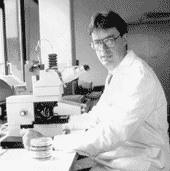
Edition 1/96
 Edition 1/96 |
Rapid Identification |
 “I’m not pessimistic about the situation but we do need to reduce the competitive advantage of resistant strains by using less antibiotics...”
“I’m not pessimistic about the situation but we do need to reduce the competitive advantage of resistant strains by using less antibiotics...” After taking samples from patients in the 594-bed hospital adjoining the laboratory, Professor Goossens’ research team frequently turns to the BCCM™/LMG collection. “Often, when we have identified a strain we send it to the BCCM™/LMG for confirmation of our analysis and storage of the sample,” he explains.
Professor Goossens’ research team has put a lot of effort into the development of typing systems. “It is vital to develop and encourage the use of rapid typing techniques,” he explains. “Using PCR, for example, we can identify the strain causing an infection - and its level of resistance - in around three hours. In the event of a nosocomial epidemic this helps us to build up a picture from patient to patient - we can establish whether one or several strains are responsible and the degree of risk, and modify our treatment strategy accordingly. For example, if it appears that an epidemic is due to one strain that is somehow travelling around the hospital, it may be necessary to introduce or change confinement procedures.”
Like the majority of his colleagues, Professor Goossens is worried that the genes responsible for resistance in VRE could be transferred to staphylococci in the clinical situation, as has already been demonstrated in vitro. “Staphylococci are responsible for 40-50 per cent of septicaemias and antibiotics are still the main line of defence,” he explains. “I’m not pessimistic about the situation but we do need to reduce the competitive advantage of resistant strains by using less antibiotics and we need to continue research into resistance mechanisms.”
BCCM™/LMG also has a role to play in furthering such research. As Professor Goossens explains: “When we are examining the resistance mechanisms, we can be certain of the authenticity of one of our samples, retrieved from the BCCM™/LMG, and we can cite its catalogue reference so that other teams can verify our results.”
 BCCM BCCMHome |
Contents Edition 1/96 | Back to main article |